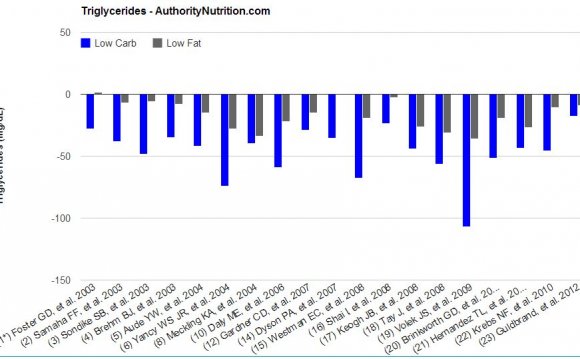
 Savvy nutrition and fitness enthusiasts know there's more than one way to do things. They've seen firsthand that a variety of diets—not just one—can improve health and weight loss, particularly when it comes to overweight fitness novices. But in the media and culture at large, an answer this reasonable has never sufficed. Low-carb and low-fat proponents have waged an epic battle over the past few decades, with each camp eager to use new studies as a knockout blow for the other.
Savvy nutrition and fitness enthusiasts know there's more than one way to do things. They've seen firsthand that a variety of diets—not just one—can improve health and weight loss, particularly when it comes to overweight fitness novices. But in the media and culture at large, an answer this reasonable has never sufficed. Low-carb and low-fat proponents have waged an epic battle over the past few decades, with each camp eager to use new studies as a knockout blow for the other.
The latest salvo is a yearlong study of obese patients conducted at Tulane University.1 Media coverage announced the study almost unanimously as a victory for low-carb diets, touting the extra weight loss that a "low-carb group" (those sarcasm quotes will make sense soon enough) experienced when compared to a low-fat group. Pundits even tied the results to the newly low-carb—and much thinner—LeBron James.
The low-carb group also happened to improve a variety of predictors of heart disease. This seems at first glance like a big deal, since a common knock on low-carb, high-fat diets has been their potential impact on heart health.
Nail in the coffin; time to bust out the bacon-wrapped butter sticks, right? Not so fast. Let's look behind the headlines and see what really went down.
WHAT DID THE RESEARCHERS DO?
The trial specifically studied obese people in Louisiana. The researchers noticed that previous low-carb trials often included low proportions of black people, so they made this trial more representative, with over half the subjects being black.
 However, the researchers enrolled no Asians and very few Latin-Americans, and the study was composed of almost 90 percent women.
However, the researchers enrolled no Asians and very few Latin-Americans, and the study was composed of almost 90 percent women.
With those demographic details aside, here's how the two groups lined up:
Low-carb group
- Told to eat fewer than 40 g of carbs per day for one year.
- Instructed not to change activity levels.
- Given meal replacement and dietary counseling.
Low-fat group
- Told to cut dietary fat intake to lower than 30% of daily calories for one year.
The researchers aimed for a low number of carbs—40 g per day, or about two slices of bread—to avoid a common problem with previous studies that claimed to be studying low-carb levels. Most recommended around 100 g of carbs per day, which, while technically "low-carb, " is still more than the amount consumed by many low-carb diehards.
When you take an obese subject who has eaten a standard American diet over the course of 40-60 years and tell them to drastically change their habits, the results can be unpredictable.
To help combat this, each group was also subject to two co-interventions along with their recommended macronutrient intake:
- Meal replacement: Participants were given a meal replacement bar or shake every day. These meal replacements were either low-carb or low-fat, depending on their prescribed diet.
 Counseling: Participants met up in small group counseling sessions, along with a dietician, in order to learn about dietary guidelines and receive support.
Counseling: Participants met up in small group counseling sessions, along with a dietician, in order to learn about dietary guidelines and receive support.
With these two safeguards in place, there was no way anyone could screw it up, right? Not quite. Sure, completion was 80 percent, a very high rate for a diet study. On the other hand, calories were not directly controlled, and adherence was self-reported.
For instance, the subjects reported an average intake of 2, 000 calories per day before either diet. This seems implausible, and emphasizes how inaccurate self-reporting can be.
So we must take all the stats with a grain of salt.
THINGS DIDN'T GO AS PLANNED
Regardless of what the researchers intended, the study ended up comparing a diet that was just barely low-carb and a diet that could barely be classified as low-fat.
The low-carb group, while instructed to consume under 40 g of carbs, never managed to get anywhere near that low of a number. To their credit, they did make big changes for the first three months, slashing their carb intakes from about 240 g per day to under 100 g. But that trend didn't continue, with average carb intake rising back up a bit to just under 130 g per day after 12 months.
So if the low-carb group succeeded in halving their carb intake, did they compensate by increasing their other macronutrients? Sort of. They ended up eating about the same absolute amount of fat as they did before, but upped their protein intake over the course of the year, from 18 percent of calories to 25 percent—significantly more protein than the low-fat group ate.
All other things being equal, cutting some fat doesn't improve heart disease predictors as much as cutting carbs.
The low-fat group's diet, on the other hand, didn't end up being all that different in proportional fat content from the standard American diet. Their fat intake at the start was 35 percent of total calories, and it went down to 30 percent. But since the low-fat group cut their overall caloric intake by about 500 calories per day by the end of the study, their overall fat intake went down by about 30 g per day. That's about the equivalent of two fatty burger patties per day, which is quite a bit—especially in caloric terms.
So what did the low-fat group replace all that fat with? You guessed it: more carbs, of course! They still ended up cutting total calories to about the same level as the low-carb group, but their carb intake went through the roof—upwards of 50 percent of total calories.
INTERESTING VIDEO












